Types of greenhouse: 6 structural styles to choose from
Knowing all about the different types of greenhouse available makes it easier to pick the best design for your plot
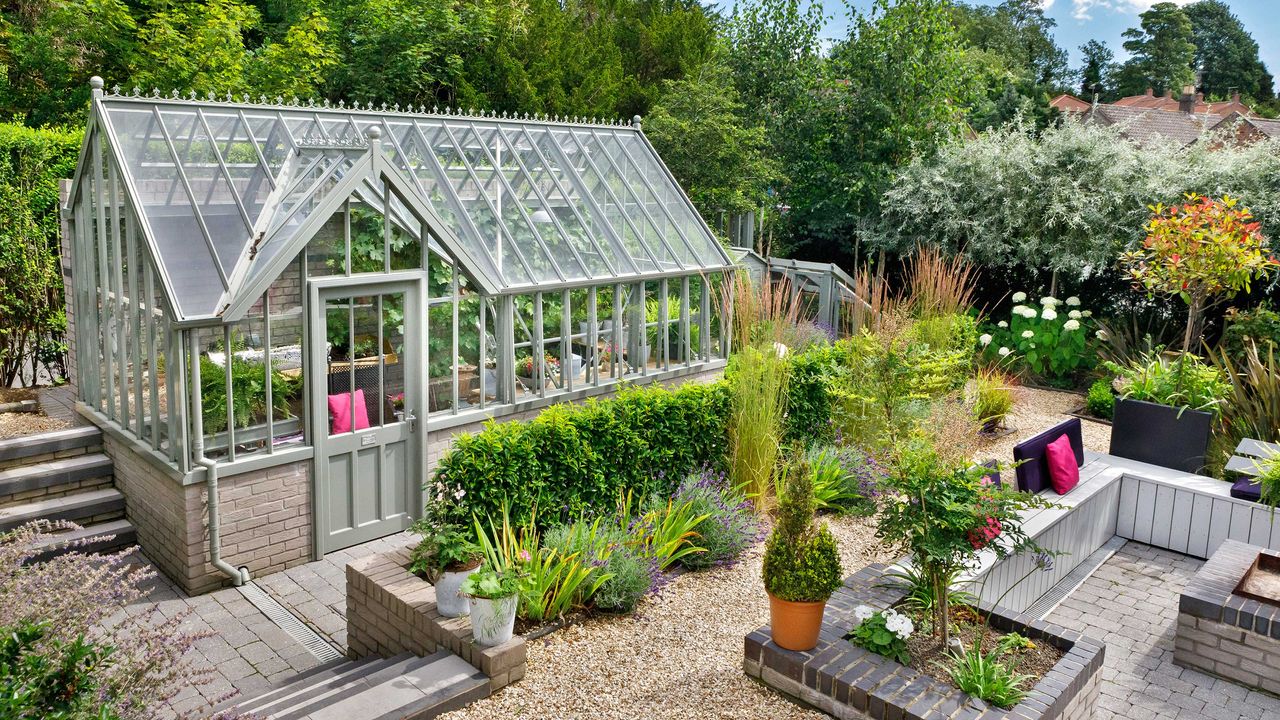

Choosing between the different types of greenhouse for your space needn't be tricky. Once you know what's available, and the differences between them, it's much easier to narrow down your choices and pick the best one for your outdoor space. And that's where we come in to help.
If you've checked out our DIY greenhouse ideas, you'll already know how many opportunities these structures present. Of course, they're a fantastic way to get seedlings off to a good start, but they are also useful for protecting tender plants and raising exotic crops such as chilies, melons, and aubergines.
Any greenhouse is a worthwhile addition to your plot, but some styles will be better suited than others. Our guide will give you the lowdown on the most popular designs.
6 different types of greenhouse for upping your garden's growing potential
Want to work out the best greenhouse ideas for your plot? Perusing through our round-up of styles is a good place to start.
Whether you have a small patio or a large garden, one of these types of greenhouse will be the perfect fit.
1. Lean-to
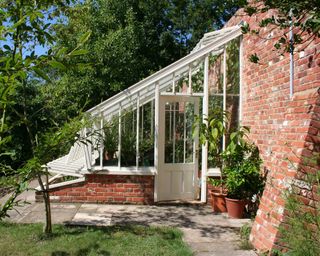
A beautiful lean-to greenhouse from Alitex
Wondering how to choose a greenhouse that will work in a small space? A design like this could be the best solution.
'Lean-to greenhouses are ideal for those wanting to enhance walled gardens, create a feature wall, or are limited on garden space,' explains Tom Hall, owner of Alitex Greenhouses.
'There are many benefits of a lean-to greenhouse. First, they can be installed in even the smallest garden or courtyard space so anyone can have a greenhouse; they are not just limited to those with a large outdoor space,' he says.
'Second, a key benefit of a lean-to greenhouse is warmth. If sited against the wall of your house, your greenhouse will benefit from the warmth inside your home. Even if it is built against a garden wall with no residual heat, it will still retain heat in an efficient manner.' This will extend your growing season significantly and help reduce the money and effort involved in learning how to heat a greenhouse.
'An added benefit of installing a greenhouse close to the house is the proximity to its amenities, often making it easier to install utilities such as electricity and water,' Tom continues. 'You could plumb in hot water for the benefit of handwashing, as well as extend the growing season throughout the winter months by growing exotic fruits, such as pineapples, by using a soil cable.'
2. Freestanding
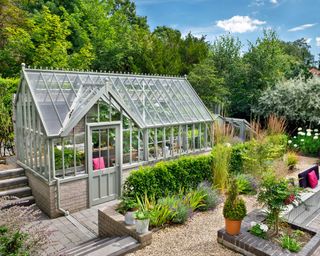
This freestanding greenhouse from Alitex complements the surroundings perfectly
A freestanding greenhouse is an ideal solution for those with flexible garden landscapes that aren't limited by space or other structures, as says Tom.
These designs allow for variation in orientation and position to suit your individual growing needs. 'This style will enable keen gardeners to house an array of crops which will benefit from an abundance of light and sunshine in the spring and summer months, as well as an even ventilation allowing the plants to thrive,' he says. What's more, Tom explains how the combination of roof and side vents will create a 'chimney-effect' inside the structure, encouraging air circulation throughout.
Tom also advises that a good rule of thumb when opting for a freestanding greenhouse is to leave at least 3.3ft (1m) of space all around. This will maximize natural ventilation and minimize shade, and it will also give you enough space for a water butt or two – ideal for upping your sustainable garden credentials.
Many freestanding greenhouses also offer enough space to be transformed with fabulous garden room ideas for relaxing, or even entertaining. Comfy seating, a small table or two, and a cozy rug underfoot can all help turn them into blissful outdoor retreats.
3. Abutting
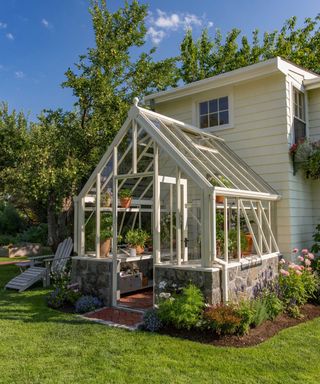
An abutting greenhouse from Hartley Botanic
'Abutting greenhouses and glasshouses are typically attached to a building by their side,' explains the team at Hartley Botanic. They are similar to a conservatory in this way.
The result can look truly stunning and architectural, particularly if you match the materials to the exterior of the property, either in texture or color.
They can also be very practical, as you won't even have to leave the house to get growing. Because of this, they're ideal for blurring the divide between your home and garden, and we can guarantee you'll be extra grateful for them throughout the cold, winter months.
Need more inspiration on what to grow in a greenhouse? You can find our top suggestions in our dedicated guide.
4. Combi
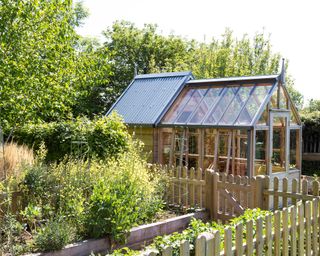
The RHS Rosemoor Combi from Gabriel Ash has space for seedlings as well as garden tools
Almost every garden needs some good shed ideas. But if you're looking for a greenhouse too, a combi may be the perfect solution.
These structures are – you've guessed it – part greenhouse and part shed. This is a really convenient approach if you want somewhere to store tools as well as grow plants, as it combines the two in one neat structure.
Situate it near your veg plot and you'll have everything you need nearby while you're busy tending to your crops over the seasons. It will make life much easier than having to traipse up and down the garden every time you need to grab a spade or collect your seedlings for planting out.
5. Mini
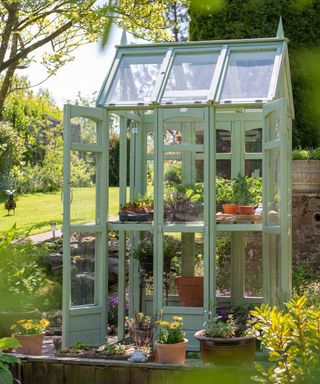
This mini greenhouse has been painted in 'Sedge Green' from Thorndown Paints
Not all of us have acres of space to play with, which means only smaller types of greenhouse will work.
Enter our round-up of best mini greenhouses – all of which are compact, stylish, and will still enable you to grow delicious crops and beautiful blooms.
Sure, you won't be able to treat it like a garden room. But, whether you go for glass, plastic, timber, or sturdy shelves with removable covers, they can be a valuable feature for patios, courtyards, and balconies if you're eager for some grow-your-own action. And, they tend to be much more affordable than larger designs, too.
6. Hoop-house
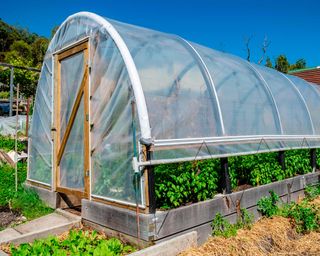
A hoop-house can be a cheaper alternative to a traditional glasshouse
If you're looking for cheap garden ideas and fancy a greenhouse, then this is another good option to consider.
Also known as polytunnels, they are constructed from a series of hoops, usually made from aluminum or PVC, then covered with a plastic film. For keen DIY-ers, they make a fun weekend project, and they're good for growing all kinds of crops. If you want to leave your structure up all year round, however, you'll need to ensure it can withstand inclement weather conditions.
They may not look as aesthetically pleasing as more traditional glasshouses, but they will definitely do the job.
What is the best type of greenhouse?
There are plenty of different types of greenhouse depending on size and budget. An aluminium frame is the cheapest and requires the least maintenance. Painted aluminium or wooden frames look far more attractive, but are more expensive; timber (with the exception of costly cedar) requires regular upkeep.
Having the lower half of the greenhouse walls built of brick means less light, but on the plus side, brick radiates heat, so is especially helpful if you’re not going to install heating. Ideally, a greenhouse should be tall to catch the maximum light, and – vitally – it requires sufficient ventilation: roof vents the equivalent of around 20% of the total floor area, as well as side vents.
Opt for a sliding door to save space and to prevent the wind (or someone’s foot) smashing the glass. And, finally, the internal layout is decided according to what you intend to grow and do in the greenhouse: for example, floor room for pot plants and grow-bags, benches (staging) for small pots and seed trays and a space to work (sowing and potting), and beds for planting.
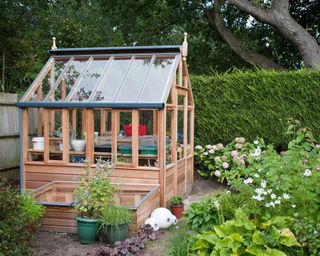

The garden was always a big part of Holly's life growing up, as was the surrounding New Forest where she lived. Her appreciation for the great outdoors has only grown since then. She's been an allotment keeper, a professional gardener, and a botanical illustrator – plants are her passion.
